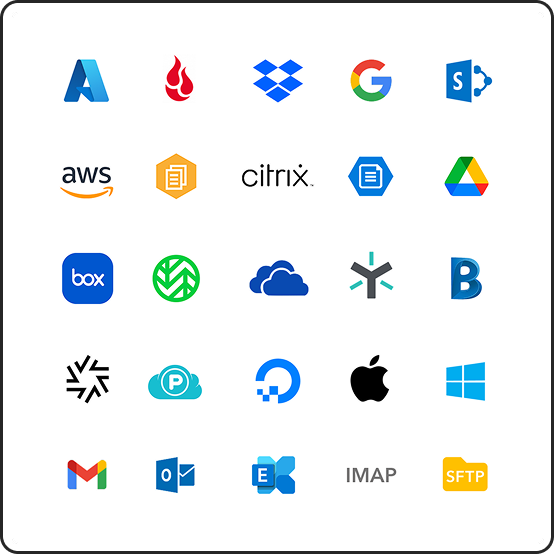One migration that is more complex than it might seem is migrating Google Workspace to another account. After all, with no differences in restrictions, file architecture, or naming conventions, it should be easy to move between Google Workspace tenants, right? Without a data migration tool, Google to Google migrations can be surprisingly difficult, but Movebot simplifies the process so you can move between tenancies with ease.

Merge Google Workspace accounts vs migrating to a new account
Depending on the type of migration you plan to do, the planning stage of the migration will be very different. Google Workspace tenant migrations will either be moving data to a new, empty account, or merging data from two accounts into one place.
Moving into an empty account
Of course, moving into a fresh account is simpler. You won't have to worry about duplications, mixing up naming conventions, any of that. All you have to do is choose what data to move and run the migration. With Movebot, you can do this kind of migration incredibly fast, whether it's just files you want to move or if you want to migrate emails, contacts, and calendars too.
Merging Google Workspace accounts
Merging or consolidating data from two accounts into one is significantly more difficult. A common use case is during a merger or acquisition, where organizations need to have data from both separate entities in one, unified location.
The main obstacle when merging data from two active accounts is making sure that all of the data makes it to the final source in a way that's usable. When coming from two different organizations, there can be a lot of overlap, so there are a few important questions to keep in mind to make sure nothing goes missing and that everyone has access to what they need.
Here are a few things to keep in mind before starting the migration itself:
- Which file hierarchy and naming convention will be used? Will there be a combination from each organization?
- Unlike most other cloud platforms, Google allows for duplicate file and folder names. How will any duplicate files and folders be handled, especially for common folder names like ones named after departments?
- Will users need to be working in both accounts while data is being migrated? Is there a plan in place to move users off the old account?
- Are there any users that won't need to be migrated to the new account? If so, is there a planned place to store any data from those user accounts?
- Do mailboxes need to be migrated along with files? Are there any users who may have valuable data but the user themselves aren't needed?
- How much data actually needs to be moved? Is there a plan in place to deal with Google's daily maximum upload limit?
Movebot can help sort many of these concerns for you automatically. You'll still need to decide on aspects like naming conventions and what data you actually need to migrate, but features like deduplication, the option to make transfers down to the folder level, exclusion criteria, and delta migrations mean most of these concerns can be handled for you as part of the migration.
Migrating Google Workspace to another account with Movebot
Movebot makes migrating between Google Workspace tenants simple. It follows a similar process to other migrations, except that the source and destination are both Google Workspace accounts.
Connecting to Google Workspace
The first thing you need to do is connect both Google Workspace accounts. To do this, log in to Movebot and create a new connection. Choose Google Workspace from the list. Choose an admin user account for the best results so you have the right permission to migrate data. You'll also need the domain for your Google Workspace Account.
When you've entered the details, click to create a Service account, which Movebot will make for you automatically. You'll then get a Client ID for the Google account which you'll need to enter to link to Movebot. Part of the process includes delegating domain wide authority in Google Admin, which you can do by following this guide.
Repeat this process for the 2nd Google Workspace account. The process only needs to be done once for each account, then Movebot will be able to access the accounts for unlimited transfer projects.
If you're moving emails as well, you'll need to repeat the process using the Google Workspace Gmail connection for both the Source and Destination.
Once you have both accounts connected, set up a project and follow the guided steps. Since they're both Google it's simple for the most part, but there are a few caveats to be aware of, such as with permission mapping.
Google to Google permission mapping
When moving between Google tenants, retaining permissions can be a little bit tricky. The most effective way is to include every email in the source environment in the project, including all users as well as any aliases and groups. You'll also want to recreate any addresses you plan to map in the destination tenant.
If the source account is being discontinued, you should still map users you don't want as part of the migration. These users can all be mapped to a service-type account in the destination if you don't need them as users. Aliases can either be mapped to the user or can be specified as an alias again.
See the table below for an example of how to set up your mappings.
| Type |
Source |
Destination |
|
User
|
User1@sourcedomain.com
|
User1@temp.soucedomain.com
|
|
Alias
|
Alias1@sourcedomain.com
|
Alias1@temp.sourcedomain.com OR User1@temp.sourcedomain.com
|
|
Group
|
Group1@sourcedomain.com
|
Group1@temp.sourcedomain.com
|
|
Non-migrating user
|
nonmigratinguser1@sourcedomain.com
|
serviceaccount1@temp.sourcedomain.com
|
|
Non-migrating user
|
nonmigratinguser2@sourcedomain.com
|
serviceaccount1@temp.sourcedomain.com
|
You can also rename users as new users or change the domain without doing a migration. Follow these instructions from Google for a step-by-step guide on how to do this.
Choose files and users to move
Movebot works a bit differently from other migration tools, because you can pick and choose what you want to migrate instead of being forced to move the entire account and all its data. Use Movebot filters to select files based on file age, modification time, extension, and more, then choose whether to include or exclude these files. Go through the rest of the settings to complete your project setup.
When the project is set up, you can do the same thing for users. Not all users have to be migrated, and you can even map one user to another, including multiple users to the same user. Movebot can help with automatic user mapping, or you can upload a CSV file if you want to create multiple mappings at once. If not, you can make them one at a time in the Movebot interface.
Movebot lets you break down migrations into unlimited smaller projects, and you can move down to the folder level if you want to. This gives you greater control over the migration, both helping to speed it up and letting you choose what data to move first.
Migrating the data
Once you've added some transfers, it's time to migrate the data. If you have a larger migration, one thing to be aware of is Google's account upload limit. Typically, Google Workspace only allows an account to upload 750GB per day. However, using multiple service accounts in Google can help with this limit so that higher volumes of data can be moved in a single day, which can greatly speed up migrations in the right circumstances.
When your job is finished, Movebot will generate a post-transfer report that gives you details about your migration such as the time taken, amount of files moved, and volume of data migrated. There may also be some files that failed to move, which will be indicated in the report.
Failures aren't a major issue and there are typically a few in a large migration. That's where Movebot's delta migrations come in. When running a delta migration, Movebot checks for files that are new or modified in the source and moves them to the destination. This will pick up any failures as well since the files won't yet be at the destination Google Workspace account. You can run unlimited delta migrations until you've made sure all the files have successfully been copied to the new account.
Try Movebot for migrating Google Workspace to another account
Google Workspace tenant migrations don't have to be complicated. Movebot makes it simple by handling the hard parts for you. And with no infrastructure to worry about, everything is handled through the intuitive web interface, so all you have to do is connect the accounts, choose what to move, and go.
Try Movebot for yourself and see just how easy moving files between Google Workspace accounts can be. Every new registration gets 250GB of free data to move at sign up. And there's no credit card, sales call, or demo required, simply sign up and go if that's what you want to do. Register for your account now to get started.






